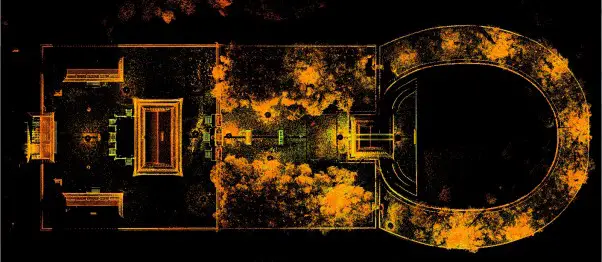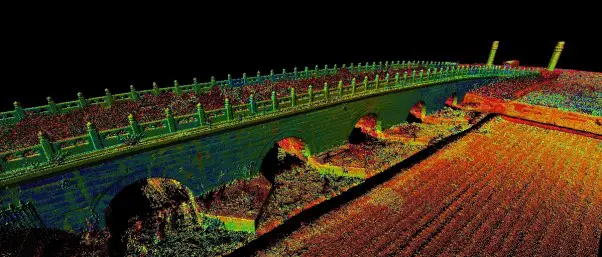The first laser scanned images of China’s Eastern Qing Tombs captured by a team of experts from Scotland have been revealed.
The historic site has been digitally captured using cutting-edge technology as part of the Scottish Ten project – a joint initiative by Historic Scotland, Glasgow School of Art’s Digital Design Studio and international non-profit organisation CyArk.
The Eastern Qing Tombs – in use from 1666 to 1911 – are the final resting place of some of China’s best known emperors. The Imperial Tombs of the Ming and Qing Dynasties were both designated as a World Heritage Site in 2000 – UNESCO describing it as a “masterpiece of human creative genius”.

Point cloud image of main tomb at Jing Ling : Credit Historic Scotland
The Scottish Ten team focused on the site’s most elaborate tomb, belonging to Xiao Ling, which was the first to be completed and exerted a profound influence on those that followed, and also recorded the Jingling Tomb of Emperor Kangxi, widely regarded as the greatest emperor of the Qing Dynasty.
The images have been released just days after a new strategy to strengthen Scotland’s relationship with China was published by the Scottish Government.

Cabinet Secretary for Culture and External Affairs Fiona Hyslop said:
“It is fascinating to see these first images from the laser scanning of the Eastern Qing Tombs. They clearly demonstrate the intricate workmanship that went into creating this incredible complex of buildings.
“The Scottish Ten team has been in Beijing since the beginning of the month working with our partners from the Chinese State Administration of Cultural Heritage and the Cultural Relics Department at the Eastern Qing Tombs. The scale of the site is an entirely new challenge for our specialists in conservation and digital heritage preservation from Historic Scotland, our experts in 3d visualisation from Glasgow School of Art’s Digital Design Studio and our international partner, CyArk.
“The Scottish Ten will create 3D digital models of our five Scottish World Heritage Sites and five international sites. On my recent visit to India I was able to hand over the resulting scanned images, digital survey information and virtual animations from the team’s work on the Rani ki Vav stepwell in Gujarat that will be used to help conserve and promote the site.
“As well as the technical data and imagery that is being produced, the ongoing international partnerships we are building give us new opportunities to deepen Scotland’s cultural ties with China, one of the key aims of our new China Strategy. It will also make a real difference to globally important heritage sites and enhance Scotland’s international reputation for leading expertise in the fields of conservation and digital technologies.”
Mr. Zhang Heqing, Deputy Inspector and Head of Division of Foreign Affairs of State Administration of Cultural Heritage, said:
“The digital preservation project of East Qing Tombs is one of the most important projects between the State Administration of Cultural Heritage of China and the Scottish government, which not only promotes the technical exchange and cooperation between China and Scotland in the preservation of cultural heritage, deepens the friendship between them, but also arouses the awareness of the public involvement in the preservation of cultural heritage.
“We hope this project could further strengthen the exchange and cooperation between China and Scotland in the field of cultural heritage, and showcase the Chinese cultural heritage to the world in a better way.”
The Tombs now join the portfolio of Scottish Ten sites being digitally scanned to create detailed three-dimensional records for future generations, which can be used to manage the sites, and provide source material for remote access and educational programmes.
In December last year Scottish First Minister Alex Salmond met with Mr. Gu Yucai, Vice Director-General of China’s State Administration of Cultural Heritage, and Ms. Lu Qiong, Vice Director of the Department of the Protection of Monuments and Sites to announce the Eastern Qing Tombs would be the third international site in the Scottish Ten project.
The advanced laser technology employed on the Scottish Ten has already captured sites as varied as St Kilda and Neolithic Orkney in Scotland, Rani Ki Vav in India and Mount Rushmore in the United States.
After completing four weeks of scanning the team have returned to Scotland.
Background :
The scanning system uses a combination of lasers and 360 degree photography to create a detailed model which is then analysed and processed at Glasgow School of Art’s Digital Design Studio and Historic Scotland. The technology can also reveal construction methods and help decipher inscriptions and creates records of unparalleled accuracy, and often provides insights not revealed by more conventional methods of survey.
Contributing Source : Historic Scotland
HeritageDaily : Archaeology News : Archaeology Press Releases






